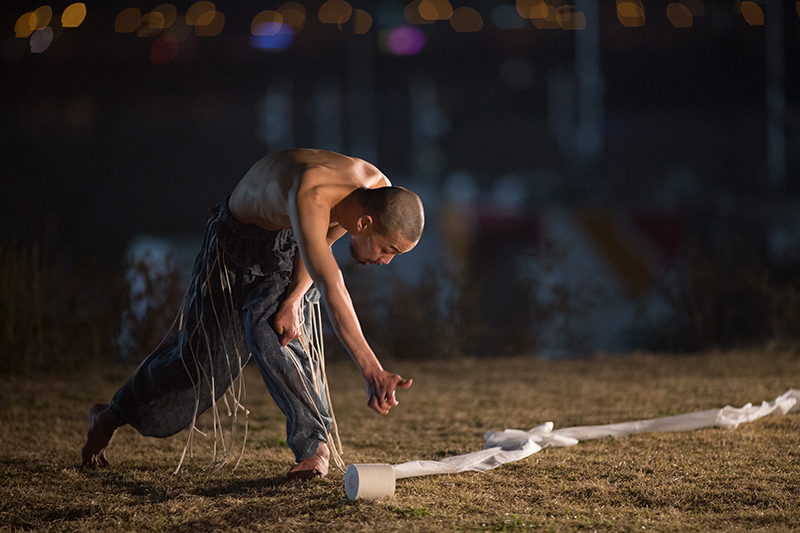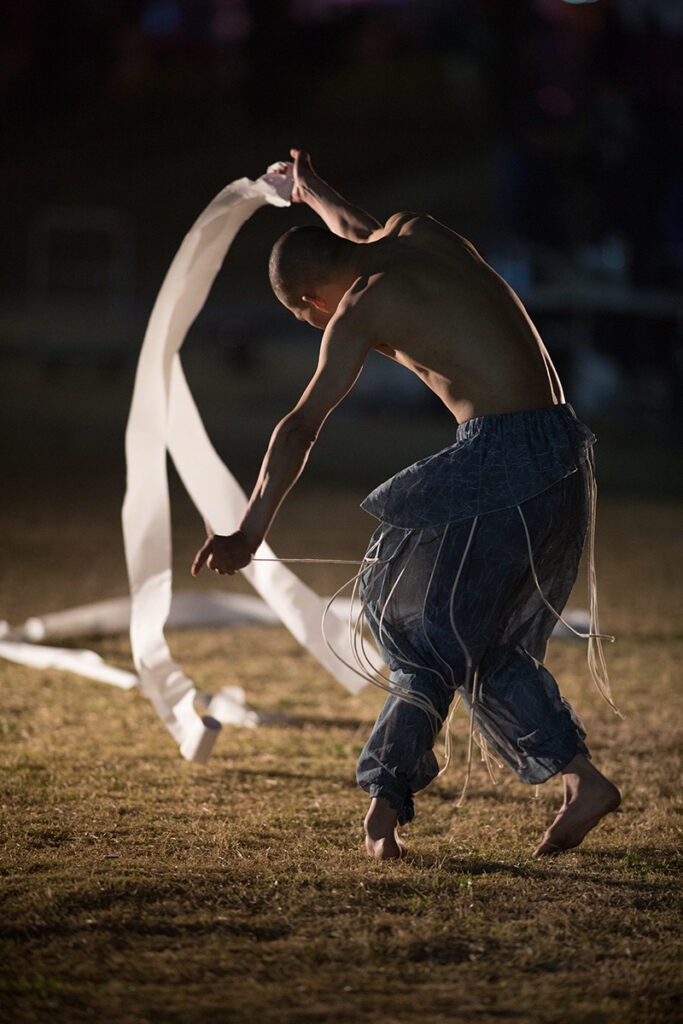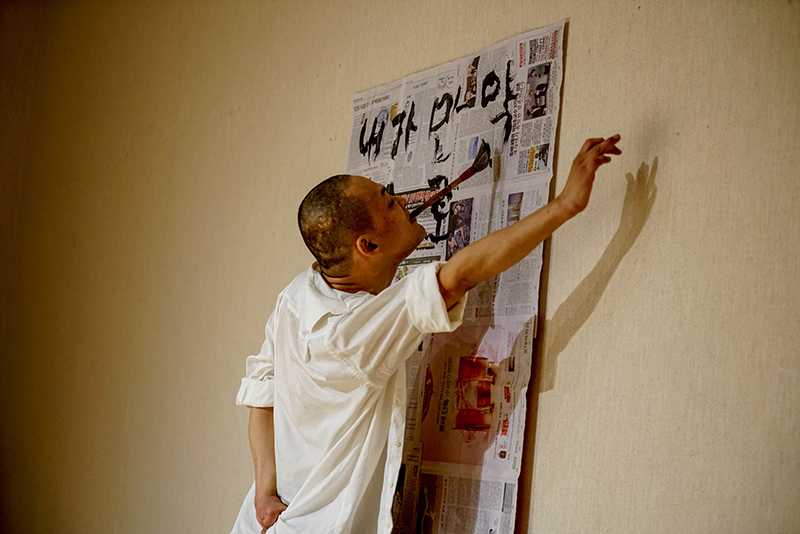Dancing the Weight of Life
An Interview with Sungkuk Kang
BY EMMALY WIEDERHOLT
TRANSLATED BY SOO JUNG BAE
Photos courtesy Sungkuk Kang
한글로 인터뷰를 읽으시길 원하신다면 스크롤을 내려주세요.
Sungkuk Kang is a dancer and choreographer as well as the director of OnMom Company, an arts organization based in Seoul with the goal of communicating with the audience through body movement in the form of performance, dance, or film. Here, Sungkuk Kang discusses his piece How to Fold that he choreographed and performed for the 2022 Korea International Accessible Dance Festival (KIADA), as well as his perception of the opportunities for dancers with disabilities in Korea.
This interview is part of a series of interviews with presenters and performers at KIADA 2022.

~~
Can you share a little about your dance history and what shaped who you are as an artist?
In 2003, there was a workshop in the Korean Experimental Art Festival for the disabled and the non-disabled. This is how I first experienced performance art. Later, after performing on the streets, I fell in love with performance art and debuted as a performance artist. In 2006, I met a friend who dances. I wanted to try dancing. So we created a piece called Blood, and this won an award at the CJ Young Festival. After that, I performed in Korea and was also invited abroad many times for eight years as a dancer for a piece called Brother, which was created by choreographer Kim Nam Jin. He created this piece when he came back to Korea after being part of C de la B, a renowned dance company in Belgium. I was invited to a festival named Six Senses, hosted by Guiling Theater in Taipei, to perform Oh! baby which is a piece I directed and choreographed. I also participated as a dancer in a piece directed by art director Lee Chun Yao. Besides that, I collaborated with Yuko Kaseki, who is a dancer and a Butoh dancer.
Nowadays I’m doing a lot of work with dancers without disabilities.
How would you generally describe your choreography to someone unfamiliar with it?
More than technique, I prioritize what’s coming from my heart. Sometimes I participate in my own choreography and sometimes I choreograph on other bodies.
How did you get involved with or introduced to KIADA?
KIADA reached out to me. This year wasn’t the first time I participated. I’ve been participating since the first festival in 2016.
Can you share some information about How to Fold, the piece you created for KIADA 2022? What was the impetus behind the piece?
This piece started from my experience when I was in middle school. I was severely bullied. The piece started from that painful experience. But I didn’t want to just focus on the pain; I wanted to talk about life, that there are differences in everyone’s life. Each and every individual has different experiences in life and every one of them has its value. That’s the kind of message I wanted to deliver. I started directing this piece from three key words: “life,” “difference,” and “path.”
There are three dancers on top of a huge roll of paper in the piece. It meant that all three dancers are supposed to look differently when they move. This implies how each life and each world is different. In the last scene, I wanted to show my sufferings and the weight of life.
What was your choreographic process creating the piece?
One of the dancers I worked with on this piece, Ju Hye Cho, was someone I have worked with before a couple of times. The other dancer, Seong Yeon Kim, was someone I haven’t worked with before. So when we started practicing, we needed a lot of time together to get to know each other. For the new dancer, it was her first time working with a disabled dancer.
We took a video dancing spontaneously using improvisation based on the three words “life,” “difference,” and “path.” After we took the video, we watched it and took out some movements and added in others. After we took the video, I would review the video repeatedly to decide where I could make revisions.
We used the paper every time we practiced; we went through a lot of paper! It took quite a long time to tape together the paper for rehearsal.
From your perspective, what opportunities are there for dancers with disabilities in your community?
Honestly, there aren’t many dancers with disabilities in Korea. It’s hard to find dancers with severe disabilities like me. And unfortunately, there aren’t many people with disabilities who try to become a dancer. Even those few dancers with disabilities, it’s hard to find opportunities. Obviously, it’s better than the past. But for people without disabilities, you can go to private schools to study dance. That option is not open for people with disabilities.
When there are festivals, I apply. There are also organizations that reach out to me, like KIADA. And there are arts-related grants that I can apply for.
When you apply for a grant, you have to do the whole process by yourself: planning, choreographing, finding performers, marketing. After you finish the whole process, you have to write a report. Doing everything by myself is quite demanding. That’s why it’s hard for me to apply for grants regularly.
How would you like to grow or expand your work in the future?
I don’t know what I want to do next. I’m 43 now. My goal is to dance until I’m 50. I’m not sure if my body will be able to keep up. I don’t know if I will be strong enough, but I want to be on the stage for as long as possible. After that, I want to find a way to contribute to the development of disability art.
Making a piece of art is related to having time and money. I’m having a difficult time financially. There are many different things I want to try, but I don’t have enough financial support.

~~
삶의 무게를 춤으로 추다
강성국 무용수와의 인터뷰
에말리 위더홀트(Emmaly Wiederholt) 작성
배수정 번역
사진 제공 강성국
강성국 무용수는 온몸컴퍼니의 감독이자, 안무가이자, 무용수입니다. 온몸컴퍼니는 서울을 기반으로 하는 예술 단체로, 공연• 무용• 영화 등을 통해 신체적인 움직임으로 관객과의 소통을 추구합니다. 본 인터뷰에는 2022년 강성국 무용가가 연출하고 대한민국 장애인 국제 무용제(키아다, KIADA)에서 공연한 작품 <접는 법>에 대한 이야기가 실려 있습니다. 또, 한국에서 장애가 있는 무용가에게 주어지는 기회에 대한 생각도 실려 있습니다.
본 인터뷰는 키아다 2022에서 공연을 한 무용수들과 안무가들의 인터뷰 모음집의 일부입니다.
~~
과거에 어떤 무용을 해오셨는지, 어떻게 무용을 하게 되셨는지에 대한 경험을 나눠주실 수 있으신가요? 또, 예술가가 되는 것에 영향을 미쳤던 것이 있나요?
2003년 한국실험예술제의 부대행사였던 장애인과 비장애인이 함께하는 워크숍에 우연히 참가하여 퍼포먼스 아트(행위예술)를 접했고, 거리에서 공연 후 행위예술의 매력에 빠지게 되어 퍼포먼스 작가로 데뷔했습니다. 2006년에 무용을 하는 친구를 알게 되었고, 무용작품을 해보고 싶어 <핏줄>이라는 작품을 만들어 CJ영페스티벌에서 최우수상을 수상했습니다. 그 후, 벨기에의 유명무용단 세드라베에서 활동하다 귀국한 김남진 안무가의 작품 <Brother>의 무용수로 8년간 국내와 해외 여러 국가에서 초청받아 공연을 하였습니다. 그 후 제 연출, 안무작 <Oh! baby>로 타이페이 Gulling theatre에서 주최한 ‘Six Senses’ 페스티벌에 초청되어 공연했고, 예술감독인 Lee-chun Yao 의 연출 작품에도 무용수로 참여했습니다. 그 외 베를린에 거주하고 있는 부토 무용가 겸 무용수 ‘Yuko kaseki’와 협업으로 한국, 베를린에서 같이 공연을 하기도 했습니다. 일단 지금은 그렇게 작업을 하고 있고요, 장애가 없는 무용수들하고 작업을 많이 하고 있습니다.
선생님의 무용·안무에 대해 잘 모르는 사람들을 위해서 선생님의 무용을 알려주신다면, 대략 어떻게 설명해주실 수 있나요?
테크닉이 중요한 게 아니고 가슴에서 올라오는 게 제일 중요하다고 생각하고 있어요. 제가 무용수로 참여할 때도 있고요, 제가 안무를 짜서 무용을 할 때도 있어요.
키아다를 어떻게 소개받게 되었나요? 어떻게 키아다와 함께하게 되었나요?
키아다에서 먼저 저한테 섭외가 왔어요. 그래서 2016년 1회 때부터 계속 공연을 해왔어요.
올해 키아다에 올려진 작품 <접는 법>에 대해 조금 설명을 해주실 수 있나요? 작품의 탄생에 영향을 준 계기나 동기가 있을까요?
이 작품의 시작은 제가 중학교 때 심하게 왕따를 당했어요. 그래서 그 아픔이 시작이 되었고, 꼭 또 아픔을 이야기하는 것보다 삶, 사람이 사는 것에 있어서 자기 방식이 있고 자기 길이 있고, 자기의 삶이 다 다르고, 그만큼 각자의 삶이 가치가 있다는 메세지가 있는 작품이에요.
여기서 키워드가 세 가지가 있어요. 하나는 “삶”, 하나는 “다름”, 그리고 하나는 “길”. 이 세 가지 키워드를 가지고 제가 연출을 하고 안무를 짜게 됐어요.
종이 뭉치 위에서 세 무용수가 움직이는 상황이 세상을 표현한 거에요. 종이 위에서 세 무용수가 움직일 때 각자 다른 모습을 살아간다는 것, 자기 세상을 갖고 있다는 것을 의미하고요. 마지막에는 저의 아픔이나 삶의 무게라는 의미가 내포해있죠.
작품을 만드시는 과정이 어땠는지 설명해주실 수 있나요?
제일 중요한 게, 함께한 안무가 조주혜씨하고는 제가 같이 공연을 몇 번 해봤어요. 하지만 김성연씨는 이번에 처음 같이 해본 친구였어요. 연습 시작하고 나서 처음에는 서로 알아가는 시간을 많이 가졌어요. 그 친구는 장애가 있는 사람하고 공연하는 게 처음이어서 같이 호흡을 맞출 시간이 많이 필요했던 것 같아요.
일단 처음에는 세 가지 키워드를 가지고 각자 즉흥으로 안무를 해보고, 그걸 비디오로 찍었어요. 영상을 보면서 어떤 건 살리고 어떤 건 빼고 이런 식으로 작업을 했어요. 영상을 계속 보면서 어떻게 바꿀 수 있는지 생각을 많이 했어요. 다 즉흥은 아니고 어떤 부분은 안무가가 먼저 안무를 짜고 이런 식으로 작업을 했어요.
종이를 많이 사용했는데, 연습할 때마다 사용했어요. 종이를 붙이는 시간이 되게 오래 걸려서 조금 힘들었어요.
선생님이 보시기에, 선생님이 속한 공동체에는 장애를 가진 무용수들에게 어떤 기회가 찾아오나요?
솔직히 한국의 경우 장애를 가진 무용수가 그렇게 많지 않아요. 특히 저같이 이렇게 장애가 심한 무용수는 거의 없어요. 일단 하는 사람도 없고, 하려고 하는 사람이 없는 게 제일 아쉬운 것 같아요.
하려고 하는 사람들한테도 기회가 많이 주어지지 않아요. 무용이 배워보고 싶어도 갈 수 있는 학원이 있는 것도 아니니까요. 기회가 옛날보다는 많이 생기고 있기는 하지만, 그래도 기회가 많이 없는 것 같아요.
페스티벌에 공모를 하거나 다른 데에서 섭외가 올 때가 있어요. 그리고 예술지원사업이라고 해서 공모를 하는 것들이 있어요. 그러면 제가 지원을 받아 기획을 해서 공연하는 것도 있어요.
공모를 할 때 제가 하나부터 열까지 다 해야 하기 때문에 매일 하기에는 무리가 있어요. 공모 신청부터 무용수 섭외, 작품 만들기, 공연, 홍보, 보고서 작성 등 모든 것을 다 혼자 해야 해요.
선생님께서는 미래에 선생님의 작업을 어떻게 확장하고 또 성장시키고 싶으신가요?
다음에 뭘 할지 잘 모르겠어요. 그런데 제가 이제 지금 나이가 마흔 셋이에요. 무대 위에 한 오십 살까지 계속 서고 싶은데 모르겠어요. 이게 몸이 따라줄 지는 잘 모르겠지만, 최대한 오래 무대 위에 있고 싶어요. 그 이후에 장애 예술 발전에 있어서 제가 뭐 할 수 있는 게 있다면 그런 건 하고 싶어요. 솔직히 지금도 여러 가지 해보고 싶은 게 많기는 해요. 하지만 재정적인 여유가 안 되기 때문에, 하고 싶은 걸 할 수가 없어요.

~~
